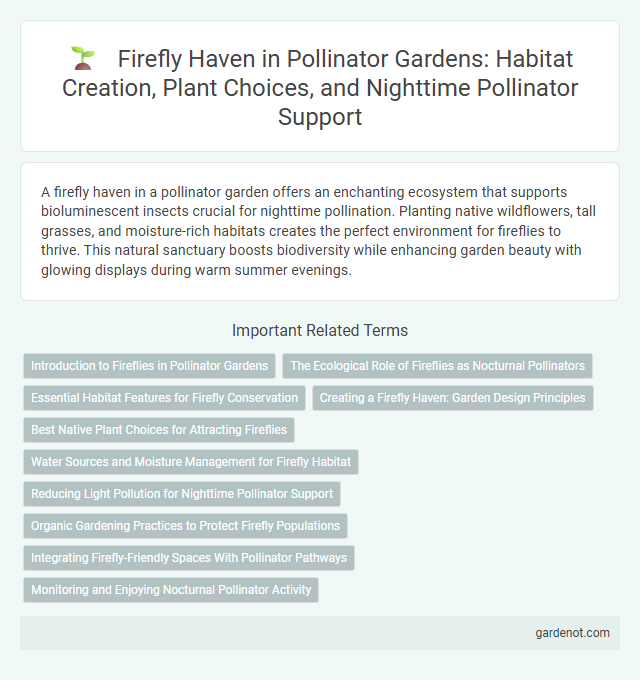A firefly haven in a pollinator garden offers an enchanting ecosystem that supports bioluminescent insects crucial for nighttime pollination. Planting native wildflowers, tall grasses, and moisture-rich habitats creates the perfect environment for fireflies to thrive. This natural sanctuary boosts biodiversity while enhancing garden beauty with glowing displays during warm summer evenings.
Introduction to Fireflies in Pollinator Gardens
Fireflies, also known as lightning bugs, are bioluminescent beetles that play a crucial role in pollinator gardens by enhancing nighttime biodiversity. These insects use their glowing abdomens to attract mates, and their presence indicates a healthy ecosystem rich in native plants and insects. Incorporating native flowering plants and moist habitats in pollinator gardens creates an ideal firefly haven, supporting their life cycle and promoting natural pest control.
The Ecological Role of Fireflies as Nocturnal Pollinators
Fireflies play a crucial ecological role as nocturnal pollinators, aiding in the reproduction of various night-blooming plants by facilitating pollen transfer under low-light conditions. Their bioluminescent signals attract mates and inadvertently support plant biodiversity by promoting genetic exchange through cross-pollination. Conserving firefly habitats within pollinator gardens enhances ecosystem health by sustaining these essential nocturnal pollination networks.
Essential Habitat Features for Firefly Conservation
Firefly havens require dense, moist vegetation, such as tall grasses and wildflowers, providing both shelter and breeding grounds essential for larval development. Stagnant water sources or damp soil zones support egg laying and larval survival, creating a critical microhabitat. Minimizing light pollution enhances firefly signaling behavior, boosting mating success and sustaining population health.
Creating a Firefly Haven: Garden Design Principles
Designing a firefly haven involves planting native wildflowers and tall grasses that provide shelter and breeding grounds essential for firefly survival. Incorporating water features like shallow ponds or damp soil areas helps maintain the humidity levels fireflies need for reproduction. Avoiding pesticides and using organic gardening methods also fosters a safe environment where firefly populations can thrive naturally.
Best Native Plant Choices for Attracting Fireflies
Selecting native plants such as Joe-Pye weed, milkweed, and goldenrod provides essential habitats and food sources for fireflies in a pollinator garden. These plants support the larvae's need for moist soil and insects, enhancing firefly populations effectively. Incorporating native grasses like switchgrass also creates ideal conditions for firefly mating displays and nighttime activity.
Water Sources and Moisture Management for Firefly Habitat
Water sources such as shallow ponds, damp soil, and slow-moving streams are essential for creating a firefly haven, providing the moisture necessary for their lifecycle stages from larvae to adult. Maintaining consistent moisture through mulching and strategic watering helps sustain the aquatic environment fireflies require, promoting successful breeding and larval development. Proper moisture management reduces habitat dryness, supporting the fireflies' nocturnal displays and overall population health.
Reducing Light Pollution for Nighttime Pollinator Support
Firefly habitats thrive in environments with minimal artificial light, making reducing light pollution essential for supporting nighttime pollinators. Implementing outdoor lighting strategies such as using low-intensity, warm-colored bulbs and directing light downward preserves firefly mating signals and enhances their activity. Creating dark garden zones benefits fireflies and contributes to a balanced nocturnal ecosystem, promoting biodiversity in pollinator gardens.
Organic Gardening Practices to Protect Firefly Populations
Firefly haven gardens thrive through organic gardening practices that avoid pesticides and synthetic fertilizers, preserving the delicate ecosystems fireflies rely on for breeding and feeding. Incorporating native plants and maintaining moist, leaf-littered areas provide essential habitat and food sources for firefly larvae. These sustainable methods enhance biodiversity while supporting healthy firefly populations critical for natural pest control and nighttime pollination.
Integrating Firefly-Friendly Spaces With Pollinator Pathways
Creating firefly-friendly spaces within pollinator pathways enhances biodiversity by providing essential habitats for these nocturnal insects. Incorporating native plants that attract fireflies, such as milkweed and goldenrod, supports their life cycle while complementing pollinator gardens designed for bees and butterflies. Strategically integrating moist, shaded areas and avoiding pesticides ensures a thriving environment for fireflies, contributing to healthier ecosystem connectivity.
Monitoring and Enjoying Nocturnal Pollinator Activity
Firefly Haven thrives as a dedicated pollinator garden designed to support and monitor nocturnal pollinators, especially fireflies, whose bioluminescent activity indicates a healthy ecosystem. Employing low-impact lighting and native plant species, visitors can observe the enchanting glow of fireflies while researchers track their population dynamics and behavior patterns. This unique habitat fosters environmental awareness and contributes valuable data for conserving nocturnal pollinator species.
Firefly haven Infographic

 gardenot.com
gardenot.com